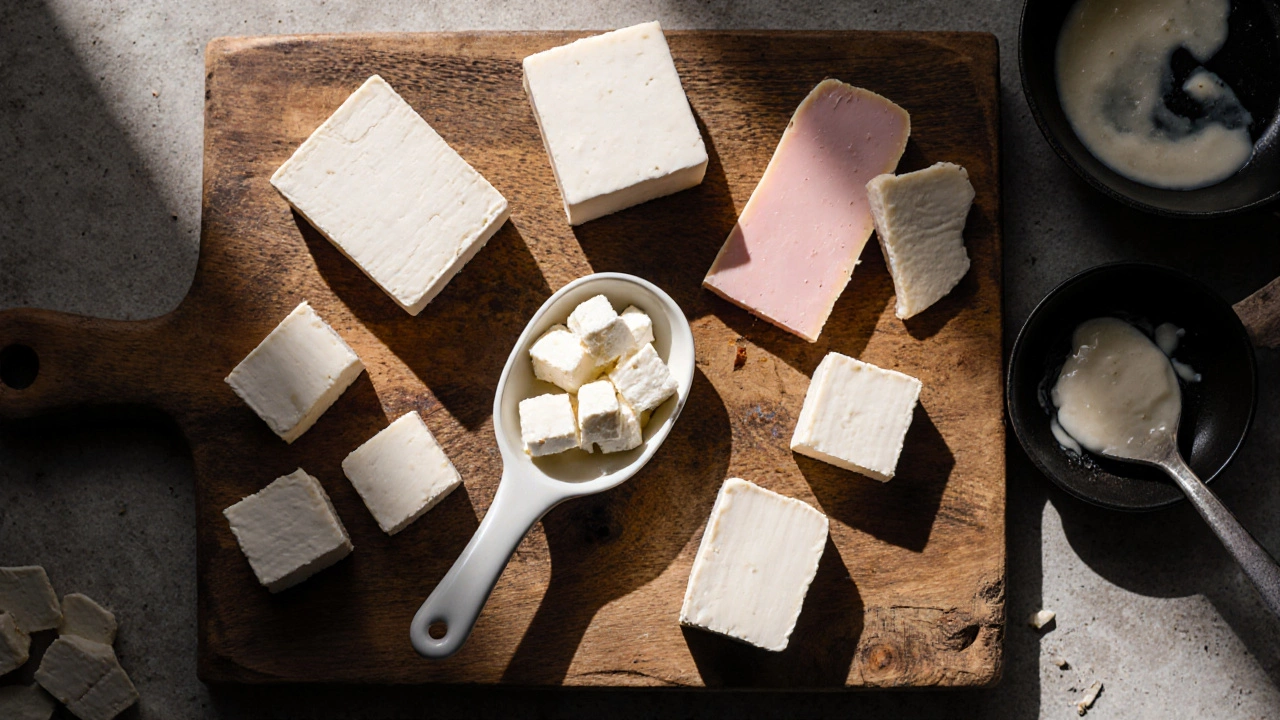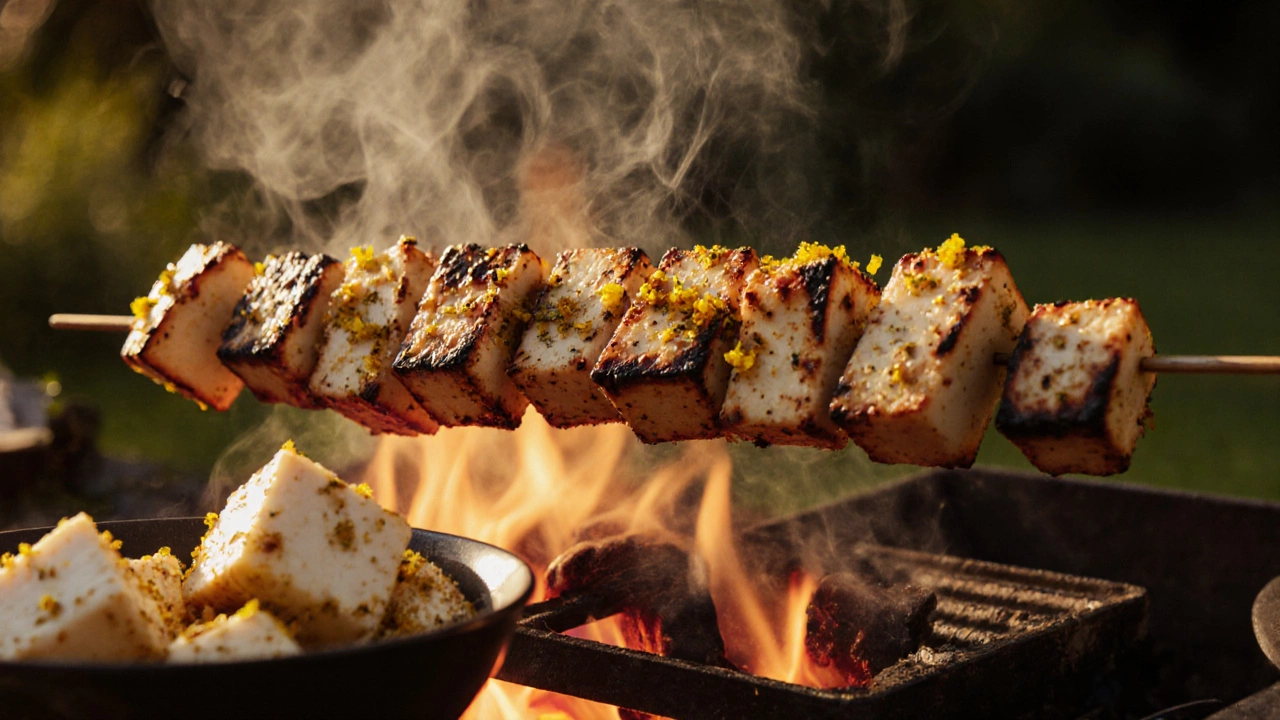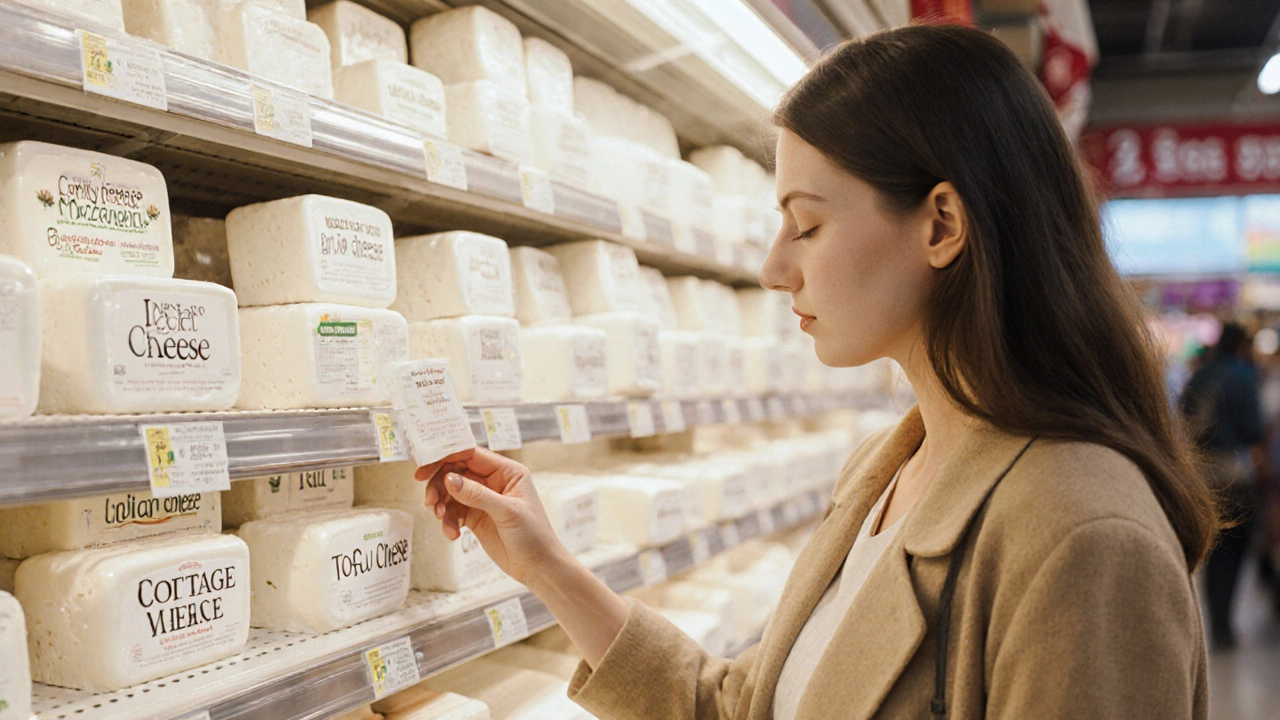Ever walked into a grocery aisle abroad and wondered why the label for that soft, milky cheese isn’t "paneer"? You’re not alone. In many Western supermarkets the same product shows up as cottage cheese, ricotta, or even tofu, and that can leave home cooks scratching their heads. This article clears up the most common foreign names for paneer, explains why those names exist, and shows how the cheese stacks up against similar dairy (and non‑dairy) options worldwide.
Key Takeaways
- Paneer is often sold abroad as cottage cheese, fresh mozzarella, or simply “Indian cheese.”
- Its texture and non‑melting nature set it apart from ricotta, halloumi, and tofu.
- When recipes call for “soft white cheese,” check the moisture level - paneer is drier than most others.
- Cooking methods that work for paneer (grilling, frying) usually work for halloumi but not for tofu.
- A quick cheat sheet at the end helps you pick the right substitute on the fly.
What Paneer is
At its core, paneer is a fresh cheese made by curdling hot milk with an acid such as lemon juice, vinegar, or citric acid, then pressing the curds into a firm block. The process leaves the cheese with a high protein content (about 18 g per 100 g) and virtually no lactose, making it a favorite among vegetarians and those with mild dairy sensitivities.
Because it doesn’t melt when heated, paneer holds its shape in curries, on skewers, and even in baked dishes. That non‑melting property is the main reason it gets a separate name in many countries - locals compare it to the cheeses they already know.
How the Name Changes When You Travel
When you leave the Indian subcontinent, the word “paneer” isn’t always on the label. Below are the most common aliases you’ll see, grouped by region.
- North America & United Kingdom: “Cottage cheese” or “Indian cheese.” Supermarkets often lump paneer in the dairy section with traditional cottage cheese, even though the texture is firmer.
- Europe (France, Italy, Spain): “Fresh mozzarella” or “queso fresco.” The mild flavor and soft crumbly texture make it a close cousin to these local cheeses.
- Middle East: “Labneh cheese” - a strained yogurt product that mimics paneer’s tang and dryness, though the base is different.
- East Asia (Japan, South Korea): “Tofu cheese” or “soy paneer.” Since soy products dominate, some producers brand paneer as a soy‑based alternative, even though it’s technically dairy.
These naming quirks stem from marketing strategies: retailers want shoppers to recognize something familiar, so they attach a local cheese name to paneer’s description.

Paneer vs Similar Cheeses Around the World
To help you decide when a foreign label is really paneer, compare the key attributes of the most common look‑alikes.
| Cheese | Base | Acid Used | Moisture % | Melts? | Typical Uses |
|---|---|---|---|---|---|
| Paneer | Milk (cow or buffalo) | Lemon juice / vinegar | 45‑55 | No | Curries, grilling, frying |
| Cottage cheese | Milk | Rennet or bacterial cultures | 70‑80 | Yes (soft) | Salads, desserts |
| Ricotta | Whey | Heat & acid | 70‑80 | Yes | Lasagna, pastries |
| Halloumi | Sheep/goat milk | Rennet + mint | 55‑60 | No (sizzles) | Grilling, salads |
| Tofu | Soybeans | Coagulation (calcium sulfate) | 65‑85 | Varies (soft vs firm) | Stir‑fry, soups |
| Quark | Milk | Bacterial cultures | 70‑80 | Yes (soft) | Dips, baked goods |
Notice how paneer’s low moisture and firm texture keep it from melting - that’s why it’s often paired with “grill” or “skewer” in foreign recipes. Halloumi behaves similarly, but its briny flavor and typical sheep‑milk base set it apart.
When to Trust a Substitute
If you spot "cottage cheese" in a recipe that calls for paneer, ask yourself two questions:
- Will the dish be cooked at high heat? If yes, cottage cheese will melt and become watery - not a good swap.
- Do you need a neutral taste? Both paneer and cottage cheese are mild, but paneer stays firmer.
Best substitutes by cooking method:
- Grilling or frying: Halloumi or firm tofu mimic paneer’s squeak‑and‑hold.
- Stews or curries: Use firm tofu or extra‑dry cottage cheese, pressing out excess water first.
- Cold salads: Fresh cottage cheese works fine, just season with a pinch of salt and lemon.
Remember, the classic Paneer tikka marination (yogurt, spices, lemon) works with halloumi as well - the flavor transfer is almost identical.

Common Misunderstandings
1. Paneer is the same as mozzarella. No. Mozzarella stretches when melted; paneer stays solid.
2. All white cheeses are interchangeable. Moisture content and curd size matter. A soft ricotta can’t replace paneer in a kebab.
3. Vegan paneer is just tofu. While tofu can stand in, true “vegan paneer” often adds cashew or almond paste to mimic the creaminess.
Quick Cheat Sheet: Spotting Paneer Abroad
| Label | Key Indicator | What to Do |
|---|---|---|
| Indian cheese | Packaged in blocks, low moisture | Use as is |
| Cottage cheese | Curds in a creamy liquid | Drain, press, then use for curries |
| Halloumi | Salt‑brine pack, firm texture | Great for grilling, like paneer tikka |
| Firm tofu | Boxed, pressed, white | Marinate, then fry - works in most paneer dishes |
Frequently Asked Questions
Is paneer the same as cottage cheese?
Not exactly. Cottage cheese is much wetter and has a milder flavor, while paneer is drier, firmer, and doesn’t melt when heated.
Can I use halloumi instead of paneer in a curry?
Yes, halloumi’s firm texture holds up in hot liquids, though its salty, slightly tangy taste will change the flavor profile a bit.
Why does paneer not melt like mozzarella?
Paneer’s curds are pressed tightly and contain little moisture, so the protein network can’t flow when heated, unlike mozzarella’s high‑moisture stretchable curds.
What’s the best vegan alternative to paneer?
A firm, pressed tofu mixed with a splash of lemon juice and a pinch of salt mimics paneer’s texture and tang. Some recipes also use soaked cashews blended with nutritional yeast.
Is paneer high in protein?
Yes - about 18 g of protein per 100 g, making it a solid plant‑friendly protein source for vegetarians.
Next time you’re hunting for that perfect block of Indian cheese abroad, remember these label clues and the quick cheat sheet above. Whether you end up with cottage cheese, halloumi, or a firm tofu cube, you’ll still be able to recreate the classic flavors of paneer‑based dishes without missing a beat.
